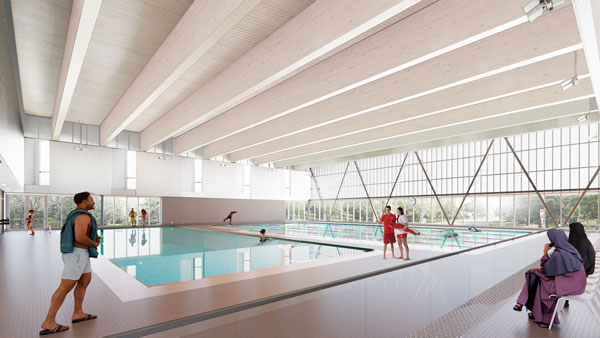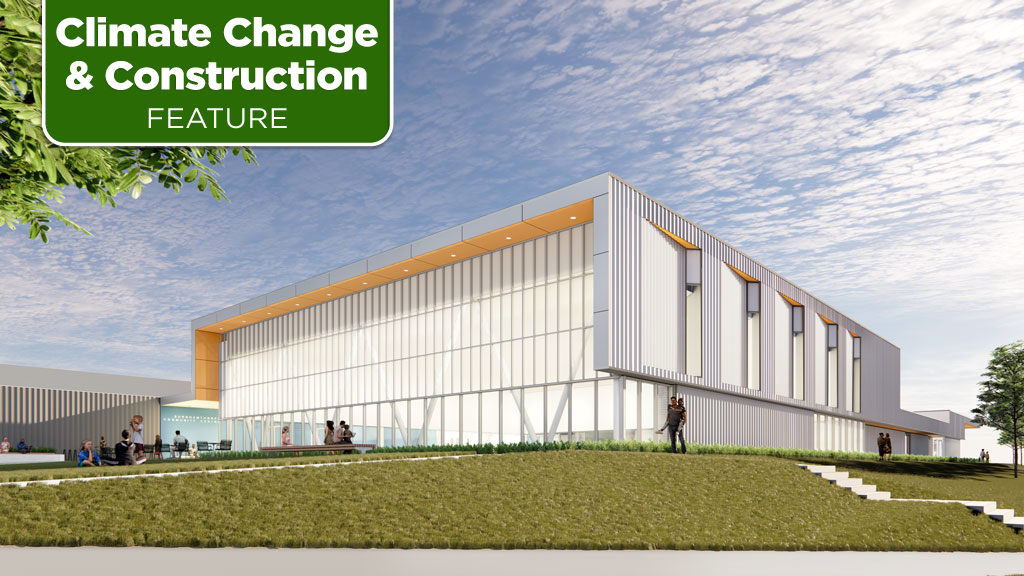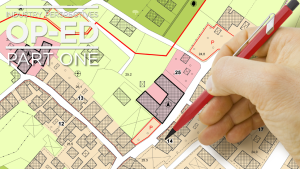It will be a green facility.
But an addition to the Burnhamthorpe Community Centre in Mississauga, Ont. will also be a signature project for the city when construction is complete and it opens in 2023.
Housing a state-of-the-art aquatic centre as well as an equipment-based fitness centre, the 2,972-square-metre wing will be the first project designed and built to the city’s Corporate Green Building Standard.
Implemented in 2019, the same year the design for this project started, the standard applies to city-owned facilities only. There is a voluntary Green Developments Standard for private sector buildings.
Located on the eastern edge of the city, the community centre was closed in March 2021 so construction could commence. The project also includes some redevelopment of the existing facility including renovations of its gym, multipurpose rooms and indoor arena.
Designed by CS&P Architects Inc., the glulam beam and steel structure is being built by construction manager Percon Construction Inc. and is intended to improve the quality of recreational services to meet population growth and changing demographics in the area.
Other project partners include corporate green building facilitator Morrison Hershfield, structural consultant LEA Consulting Ltd., and mechanical consultant H.H. Angus & Associates Ltd.
The Green Building Standard is a tier- and performance-based standard with three increasing levels of requirements, says city project manager Alexis Schneider.

“It’s similar to the approach taken by the Toronto Green Standards and the British Columbia Energy Step-Code.”
Level 1 is a mandatory requirement, Level 2 is more ambitious (and will become mandatory in 2025) and Level 3 is considered “best in class,” she explains.
Addressing issues such as energy, climate change requirements, low impact materials, transport, waste management, and water performance requirements, Level One is now the standard for the construction and renovations of city-owned buildings, she says.
And it’s the benchmark for the design, construction and choice of materials for the addition. Some of its sustainable features will include triple-glazed windows, high-efficiency lighting and rooftop solar panels, which are already in place on the existing building.
Another green feature will be a heat recovery system. Rejected heat from the existing ice plant will be harnessed to heat the swimming pool. When the pool needs to be heated, the rejected heat will be used first. If that is not adequate, the pool’s dehumidification system will provide the additional heat, says Schneider.
“The centre will be more energy efficient than if it were built according to the Ontario Building Code,” says Schneider, explaining the city is striving to meet Level 1, and is exceeding its energy targets as well reaching Level 2 on some aspects of the design.
Attaining those targets necessitated several modelling exercises and considerable upfront time and effort in the design phase from the architects and engineers. Increased construction time will also be required.
“The onus is on the contractor and the trades to push industry standards and think outside the box for creative solutions.”
Asked for an example of those creative solutions, she says Percon is constantly monitoring the cement replacement quantities in the concrete throughout the foundation forming process. That monitoring requires intensive reporting, consultation with the consultants, and “a detailed understanding of concrete performance” that would not otherwise be required on a more traditional project.The city is requiring a 20 per cent cement replacement in the concrete through the use of fly ash or slag. And when the project reaches the later stages, all of the structural steel, rebar and metal decks must be comprised of 50 per cent post-consumer recycled content.
“We’re blazing a new trail,” says Schneider, explaining those requirements will apply to all new city buildings, not just this one.
There will be an evaluation process of this project to determine what lessons can be used in the delivery of future buildings, she says.
The Green Building Standard is actually only a series of initiatives under the umbrella of the city’s Climate Action Plan.
Also implemented in 2019, it has two key goals. They include 80 per cent greenhouse gas reduction by 2050, with a long-term goal of becoming a net-zero community and increasing the city’s resilience and capacity to withstand and respond to climate events, such as extreme heat and flooding, says Schneider.











Recent Comments